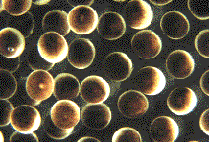







 The name amphibian means "double life", and is given to members of this
group for the double life that they lead. For while adult amphibians usually
live on land, their soft eggs must be laid in the water. The eggs shown at
left have just been shed by the female. This means that they have not yet
been fertilized; the male sheds sperm over the eggs after they have been
released into the water.
The name amphibian means "double life", and is given to members of this
group for the double life that they lead. For while adult amphibians usually
live on land, their soft eggs must be laid in the water. The eggs shown at
left have just been shed by the female. This means that they have not yet
been fertilized; the male sheds sperm over the eggs after they have been
released into the water.
Young amphibians, like the larval frog or tadpole pictured here, spend their early years in the water, breathing through gills in the side of their head in much the same way as fish do. In many ways they resemble fish more than they resemble their parents, for they have no legs, and swim by wriggling their tail. As they mature, amphibians will usually lose their gills and develop legs. A number of salamanders, such as the North American "mudpuppy" and the Mexican axolotl, develop legs but retain their larval gills and stay in the water throughout their lifetimes. This is a classic example of an evolutionary phenomenon known as neoteny -- the retention of larval or juvenile features in mature adults.

Most amphibians have soft skin which easily absorbs water. This puts them in very close contact with their surroundings. It also makes them particularly susceptible to certain man-made toxins and pollutants. This may be why the number of amphibian species, and the size of many amphibian populations, has been declining in recent years. Amphibians, like the proverbial "canary in a coal mine," may be among the first organisms to suffer from the effects of global pollution and climate change -- providing an early warning of environmental degradation.
For more information on declining amphibian populations, read FROGLOG, an on-line newsletter produced by the Declining Amphibian Populations Task Force.


